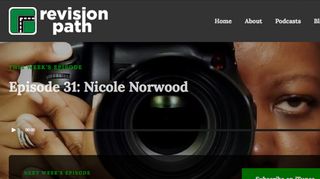Maurice Cherry on diversity and 'black design aesthetics'
The creator of the Black Weblog Awards on his experiences of working to improve diversity in the web industry.
Maurice Cherry is the creator of the Black Weblog Awards and Revision Path, a weekly podcast that showcases black web designers and developers. We spoke to him about why action is needed to improve diversity in the web industry, and the troubles that face those who undertake projects like his.
Why did you set up Revision Path and the Black Weblog Awards?
Both the Black Weblog Awards and Revision Path were started out of a need to showcase Black creative talent on the web. With the Black Weblog Awards, it was bloggers, podcasters, and video bloggers. For Revision Path, it's web designers, graphic designers, and web developers.
There's a lot of great talent out there that I felt was being overlooked and underrepresented, so I wanted to create platforms that would let these people shine.
Tell us about the response you’ve had to these projects.
Mixed, at best. People who understand the mission of what these projects are about and the vision that I'm trying to accomplish love them and think they're great.
But the sad truth is a lot of people see something like this and see Black people represented in a positive light and their knee-jerk reaction is crying racism.
Backlash from others has gotten stronger as Black bloggers and designers and such have become more powerful and more visible as makers and creators. It comes with the territory, unfortunately, but it hasn't deterred the passion that I have for these projects.
You wrote in your post about the site’s one-year anniversary that your web designer friends were enthusiastic about the project, but did not want to appear on Revision Path themselves. Why do you think that was?
I'd like to know the answer to that myself, but I've learned now that I have to just step out on faith and trust that the work that I'm doing is enough. And if the people you call friends aren't supporting you, then they're not really friends now, are they? No time for that.
How do you handle the backlash that these kinds of projects tend to evoke?
Well this has been happening on and off since 2005, so I've sort of gotten used to the backlash. It's unfortunate to even say that I've gotten used to it because I shouldn't have to.
And I'd say the same thing to anyone out there who is doing the work of showcasing underrepresented populations in this industry. Your voice is important and is sorely needed.
There are active groups of trolls out there who want to prevent change through any number of silencing tactics, and these are the people that are holding the Web back. Ashe Dryden articulates this so well in her piece on Model View Culture titled "Dissent Unheard Of".
But to answer your question more succinctly, the way I deal with most of the backlash is to ignore it and focus on the positive feedback.

What kind of actions would you like to see from the web design community to improve diversity?
Oh...several things. The web design community that is represented in popular design media is a monoculture. And whenever people make mention of this (e.g., all-White, all-male speaker panels for design conferences), there's a huge firestorm of comments, conference organizers pledge to do better next year, and everything blows over until the next offense - which at this rate happens weekly. It's a ridiculous pattern and it happens far too often.
Designers are supposed to be problem solvers, yet increasing the diversity of representation in the design community is a problem that remains unsolved.
Some will say that the web design community needs to take baby steps to improve diversity, but this is a cop-out. It's 2014, it's time for huge moon jumps to fix the issue.
Recognize that different cultural groups bring unique strengths and perspectives to the table that the larger community can benefit from that in a positive way. Make an effort to actually reach out to and understand these cultures - not just tolerate them for the sake of a "culture fit". And include people from these different cultures at the table when decisions are being made.
But in order for all of this to happen, you have to have the vision of a more diverse web design community. Once you have that, stepping outside of that bubble becomes easy, and you'll find that there are people and organizations out there that will want to help.
How do you see Revision Path and the Black Weblog Awards growing?
Well the Black Weblog Awards aren't really mine anymore! I founded the Awards in 2005 and ran them through 2011, but after that I sold them off. I'm very proud to say that the Awards are not only in very capable hands, but they will be turning ten years old soon, which is a pretty big feat for any website (especially an online awards event)!
Revision Path is a different story. After doing 50+ interviews and really hearing people's stories, I want to make sure that Revision Path is a sustainable platform for years to come.
It's already become a resource for conference organizers, design students, and Black creative professionals in the field of design. There are lots of avenues where Revision Path can grow -- networking events, conferences, etc. -- and I've already been talking with other organizations that can help make these things happen.
In the meantime, I'm continuing to focus on the podcasts and on creating more content for the blog that explores design and development through a Black lens, with a particular focus on the Black design aesthetic. Revision Path is a listener-supported venture, and
I've been fortunate for the sponsorship we've gotten through MailChimp and from generous individual donors that helps make this happen. Funding isn't easy, so support PoC-led tech organizations with your dollars as well as your words. It helps a lot!
What's the Black design aesthetic?
Well it's important to note that there isn't a single Black design aesthetic. The concept of a Black design aesthetic stems from numerous sources - music, food, history, etc. - and can vary based on location. It's design and styling and expression that are common to people of African descent.
If we're talking about here in America, the Black design aesthetic can span from antebellum times to the Harlem Renaissance to hip-hop to afrofuturism. It's a little hard to sum up in a simple soundbite, but I would highly recommend reading Sylvia Harris' essay "Searching for a Black Aesthetic in American Graphic Design Education" to get a more thorough grasp of what I'm talking about.
Are there any projects with similar aims that you admire?
Model View Culture is really knocking it out of the park -- the content is so thoughtful and powerful and raw and I look forward to every issue. I also love what Black Girls Code is doing to help empower, expose, and mentor young Black girls with an interest in STEM fields.

Thank you for reading 5 articles this month* Join now for unlimited access
Enjoy your first month for just £1 / $1 / €1
*Read 5 free articles per month without a subscription

Join now for unlimited access
Try first month for just £1 / $1 / €1
Get the Creative Bloq Newsletter
Daily design news, reviews, how-tos and more, as picked by the editors.
Tanya is a writer covering art, design, and visual effects. She has 16 years of experience as a magazine journalist and has written for numerous publications including ImagineFX, 3D World, 3D Artist, Computer Arts, net magazine, and Creative Bloq. For Creative Bloq, she mostly writes about digital art and VFX.




